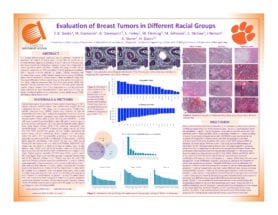Clemson students continue swine mammary gland cancer study
CLEMSON, S.C. – Some Clemson University students have taken their passion for learning and used it to continue a research project on what causes healthy cells to become cancerous cells.

They are comparing mammary gland gene expression in swine to the genes expressed in human breast cancer profiles.
Students enrolled in the Creative Inquiry project Bioinformatics for Cancer Genomics project for the 2021 Spring Semester earned 2nd place honors in the People’s Choice Awards during Clemson’s 16th Annual Focus on Creative Inquiry Poster Forum. They also were selected to present their posters during the National Conference on Undergraduate Research (NCUR) held virtually this year.
Meagan Johnson, a senior majoring in animal and veterinary sciences from Easley helped lead the NCUR presentation, which focused on the relationship between the Epithelial-Mesenchymal Transition (EMT) occurrence and cancer development. The students studied this relationship by analyzing the genetic expression of cells comprising breast cancer tumors and the stromal region surrounding the tumor tissue.
“We used laser microdissection techniques to extract RNA from luminal cells and the extracellular matrix in breast cancer tissues, looking for information regarding changes to the extracellular matrix and how this may guide tumor growth,” Johnson said. “RNA obtained from these samples allowed us to learn some of the genes expressed in the cells and evaluate those implicated in breast cancer and the EMT process.”
Alyssa Davenport, a senior in chemical engineering from Summerville said a majority of research during the spring semester was conducted online. Because swine mammary tissue was used as the model, samples were taken from swine at different stages of development and analyzed to obtain a list of genes. From that list of genes, the students were able to determine through a literature review which genes were implicated in human breast cancer. They also used The Cancer Genome Atlas to explore histology differences in patients from different racial backgrounds.
“We learned how to utilize different software to aid in our research,” Davenport said. “We also met via Zoom with students from Columbia College once a week to collaborate. Moving forward, we are excited to be able to have more hands-on lab experience.”
One of the group’s posters won 2nd place in the university’s 16th Annual Focus on Creative Inquiry Poster Forum, also held virtually. The poster was titled “Artificial Intelligence Evaluation of Breast Tumor Morphology in Different Racial Groups.”
Savannah Finley, a senior in animal and veterinary sciences from Gaffney said she believes she will benefit from the scientific writing experience she has gained while attending Clemson.
“Creating laboratory reports and research papers through other classes at Clemson University has prepared me for the scientific writing that goes into creating a scientific poster/presentation,” Finley said. “In addition, speaking with my peers and being able to explain my research project to them has prepared me for speaking to others at conferences. Ensuring that they could understand my research, whether they are in a different major or emphasis showed me that I could effectively communicate every aspect of my research.”
The students also learned more about teamwork when preparing for the presentations. Finley said preparations included ensuring each member of the group could explain every aspect of the research and answer possible questions.
The Bioinformatics for Cancer Genomics Creative Inquiry project uses a novel approach to study the mechanism that causes mammary glands to develop as a way to understand and possibly halt the growth of aggressive breast cancer cells. This project began in 2019 and is led by Heather Dunn, a senior lecturer in the Clemson Animal and Veterinary Sciences Department.
Students in this project are introduced to Clemson University resources few undergraduates know exists including the Histology Laboratory, the Clemson Light Imaging Facility (CLIF), as well as programs for bioinformatic analyses.
Field and lab work begin when mammary gland genes are collected from pigs at Clemson’s Godley Snell Research Center using the Dunn Biopsy Method. This method was created by Dunn and currently filed as a provisional patent through the Clemson University Research Foundation.
Once samples are collected, multiple laboratories are used to process the tissue. The Animal and Veterinary Science Histology Core Facility is where the students prepare the samples for analysis.
In addition to Davenport, Finley and Johnson, other students enrolled in the Bioinformatics for Cancer Genomics Creative Inquiry Project are: Emma Kate Banks, a biochemistry major from Lexington, South Carolina; Mia Damiano, a senior animal and veterinary sciences major from Fairfax, Virginia; Marena Fleming, a junior animal and veterinary sciences major from Lexington, South Carolina; Soline McGee, a senior animal and veterinary sciences major from Landrum, South Carolina and Jayla Nelson, a junior biological sciences major from Rock Hill, South Carolina.
For more information, contact Heather Dunn at walkerd@clemson.edu.
